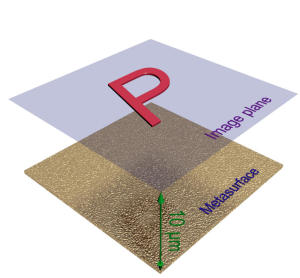
Researchers have created tiny holograms using a "metasurface" capable of the ultra-efficient control of light, representing a potential new technology for advanced sensors, high-resolution displays and information processing.
The metasurface, thousands of V-shaped nanoantennas formed into an ultrathin gold foil, could make possible "planar photonics" devices and optical switches small enough to be integrated into computer chips for information processing, sensing and telecommunications, said Alexander Kildishev, associate research professor of electrical and computer engineering at Purdue University.
Laser light shines through the nanoantennas, creating the hologram 10 microns above the metasurface. To demonstrate the technology, researchers created a hologram of the word PURDUE smaller than 100 microns wide, or roughly the width of a human hair.
"If we can shape characters, we can shape different types of light beams for sensing or recording, or, for example, pixels for 3-D displays. Another potential application is the transmission and processing of data inside chips for information technology," Kildishev said. "The smallest features -- the strokes of the letters -- displayed in our experiment are only 1 micron wide. This is a quite remarkable spatial resolution."
Findings are detailed in a research paper appearing on Friday (Nov. 15) in the journal Nature Communications.
Metasurfaces could make it possible to use single photons -- the particles that make up light -- for switching and routing in future computers. While using photons would dramatically speed up computers and telecommunications, conventional photonic devices cannot be miniaturized because the wavelength of light is too large to fit in tiny components needed for integrated circuits.
Nanostructured metamaterials, however, are making it possible to reduce the wavelength of light, allowing the creation of new types of nanophotonic devices, said Vladimir M. Shalaev, scientific director of nanophotonics at Purdue's Birck Nanotechnology Center and a distinguished professor of electrical and computer engineering.
"The most important thing is that we can do this with a very thin layer, only 30 nanometers, and this is unprecedented," Shalaev said. "This means you can start to embed it in electronics, to marry it with electronics."
The layer is about 1/23rd the width of the wavelength of light used to create the holograms.
The Nature Communications article was co-authored by former Purdue doctoral student Xingjie Ni, who is now a postdoctoral researcher at the University of California, Berkeley; Kildishev; and Shalaev.
Under development for about 15 years, metamaterials owe their unusual potential to precision design on the scale of nanometers. Optical nanophotonic circuits might harness clouds of electrons called "surface plasmons" to manipulate and control the routing of light in devices too tiny for conventional lasers.
The researchers have shown how to control the intensity and phase, or timing, of laser light as it passes through the nanoantennas. Each antenna has its own "phase delay" -- how much light is slowed as it passes through the structure. Controlling the intensity and phase is essential for creating working devices and can be achieved by altering the V-shaped antennas.

 Previous page
Previous page Back to top
Back to top







